Effects of Elevated Air Temperature and CO2 on Maize Production and Water Use Efficiency under Future Climate Change Scenarios in Shaanxi Province, China
Abstract
:1. Introduction
2. Data and Methods
2.1. Study Area Description
2.2. Data
2.2.1. Crop Management Data
2.2.2. Climate Data
2.3. Methods
2.3.1. Descriptions of the Experimental and Farmer Fields
2.3.2. CERES-Maize Model
2.3.3. Model Calibration
2.3.4. Model Evaluation Data
2.3.5. Model Setting for Baseline and Future Projections
2.3.6. Statistical Analysis
3. Results
3.1. Projected Climatic Conditions under Future Changing Climate Scenarios
3.2. Spatial Evolution of Maize Yield, ET, and WUE under Future Climate Change Scenarios
3.2.1. Maize Yield
3.2.2. Evapotranspiration
3.2.3. Water Use Efficiency
3.3. Temporal Evolution of Maize Yield, ET, and WUE under Future Climate Change Scenarios
3.4. Relationship between Crop Yield and Temperature
4. Discussion
4.1. Prospective Climate Anomalies in Shaanxi
4.2. Impact of Climate Change on Maize Yield
4.2.1. Effects of RCP on Yields under Irrigated and Rainfed Conditions
4.2.2. Comparison of CO2 Effect on Yields under Irrigated and Rainfed Conditions
4.3. Effects of RCP on ET and WUE under Irrigated and Rainfed Conditions
4.4. Comparison of CO2 Effects on ET and WUE under Irrigated and Rainfed Conditions
5. Conclusion and Future Implications
Supplementary Materials
Author Contributions
Funding
Conflicts of Interest
References
- Intergovernmental Panel on Climate Change (IPCC). Climate Change 2014: Synthesis Report. In Contribution of Working Groups I, II and III to the Fifth Assessment Report of the Intergovernmental Panel on Climate Change; Pachauri, R.K., Meyer, L.A., Eds.; IPCC: Geneva, Switzerland, 2014. [Google Scholar]
- Awais, M.; Wajid, A.; Saleem, M.F. Potential impacts of climate change and adaptation strategies for sunflower in Pakistan. Environ. Sci. Pollut. Res. 2018, 25, 13719–13730. [Google Scholar] [CrossRef] [PubMed]
- Lobell, D.B.; Schlenker, W.; Costa-Roberts, J. Climate trends and global crop production since 1980. Science 2011, 333, 616–620. [Google Scholar] [CrossRef] [PubMed] [Green Version]
- Rahimi-Moghaddam, S.; Kambouzia, J.; Deihimfard, R. Adaptation strategies to lessen negative impact of climate change on grain maize under hot climatic conditions: A model-based assessment. Agric. Forest Meteor. 2018, 253–254, 1–14. [Google Scholar] [CrossRef]
- Hatfield, J.L.; Boote, K.J.; Kimball, B.A.; Ziska, L.H.; Izaurralde, R.C.; Ort, D.; Thomson, A.M.; Wolfe, D. Climate impacts on agriculture: Implications for crop production. Agron. J. 2011, 103, 351–370. [Google Scholar] [CrossRef] [Green Version]
- Pongratz, J.; Lobell, D.B.; Cao, L.; Caldeira, K. Crop yields in a geo engineered climate. Nat. Clim. Change 2012, 2, 101–105. [Google Scholar] [CrossRef]
- Singh, P.; Nedumaran, S.; Ntare, B.R.; Boote, K.J.; Singh, N.P.; Srinivas, K.; Bantilan, M.C.S. Potential benefits of drought and heat tolerance in groundnut for adaptation to climate change in India and West Africa. Mitig. Adapt. Strateg. Glob. Chang. 2014, 19, 509–529. [Google Scholar] [CrossRef]
- Allen , L.H., Jr.; Kakani, V.G.; Vu, J.C.V.; Boote, K.J. Elevated CO2 increases water use efficiency by sustaining photosynthesis of water-limited maize and sorghum. J. Plant Physiol. 2011, 168, 1909–1918. [Google Scholar]
- World Agriculture towards 2030/2050 the 2012 Revision. Available online: https://ageconsearch.umn.edu/record/288998/ (accessed on 15 April 2018).
- Food and Nutrition in Numbers 2014. Available online: http://www.fao.org/publications/card/en/c/9f31999d-be2d-4f20-a645-a849dd84a03e/ (accessed on 15 April 2018).
- Meng, E.C.H.; Hu, R.; Shi, X.; Zhang, S. Maize in China: Production Systems, Constraints, and Research Priorities; CIMMYT: Mexico City, Mexico, 2006. [Google Scholar]
- Tao, F.; Yokozawa, M.; Liu, J.; Zhang, Z. Climate crop yield relationships at provincial scales in China and the impacts of recent climate trends. Clim. Res. 2008, 38, 83–94. [Google Scholar] [CrossRef]
- Wang, J.X.; Huang, J.K.; Yang, J. Overview of impacts of climate change and adaptation in china agriculture. J. Integr. Agric. 2014, 13, 1–17. [Google Scholar] [CrossRef]
- Saddique, Q.; Liu, D.L.; Wang, B.; Feng, P.; He, J.; Ajaz, A.; Ji, J.; Xu, J.; Zhang, C.; Cai, H. Modelling future climate change impacts on winter wheat yield and water use: A case study in Guanzhong Plain, northwestern China. Eur. J. Agron. 2020, 119, 126113. [Google Scholar] [CrossRef]
- Cortes, A.J.; Monserrate, F.A.; Ramírez, V.J. Drought tolerance in wild plant populations: The case of common beans (Phaseolus vulgaris L.). PLoS ONE 2013, 8, e62898. [Google Scholar] [CrossRef]
- Jones, P.; Thornton, P. The potential impacts of climate change on maize production in Africa and Latin America in 2055. Glob. Environ. Chang. 2003, 13, 51–59. [Google Scholar] [CrossRef]
- Hoogenboom, G.; Jones, J.W.; Wilkens, P.W.; Porter, C.H.; Boote, K.J.; Hunt, L.A.; Singh, U.; Lizaso, J.L.; White, J.W.; Uryasev, O. Decision Support System for Agrotechnology Transfer (DSSAT); DSSAT Foundation: Prosser, WA, USA, 2015. [Google Scholar]
- Hoogenboom, G.; Porter, C.H.; Shelia, V.; Boote, K.J.; Singh, U.; White, J.W.; Hunt, L.A.; Ogoshi, R.; Lizaso, J.I.; Koo, J.; et al. Decision Support System for Agrotechnology Transfer (DSSAT); DSSAT Foundation: Gainesville, FL, USA, 2019. [Google Scholar]
- Pirttioja, N.; Carter, T.R.; Fronzek, S. A crop model ensemble analysis of temperature and precipitation effects on wheat yield across a European transect using impact response surfaces. Clim. Res. 2015, 65, 87–105. [Google Scholar] [CrossRef] [Green Version]
- Challinor, A.J.; Watson, J.; Lobell, D.B.; Howden, S.M.; Smith, D.R.; Chhetri, N. A meta-analysis of crop yield under climate change and adaptation. Nat. Clim. Chang. 2014, 4, 287–291. [Google Scholar] [CrossRef]
- Dixit, P.N.; Telleria, R.; Khatibb, A.N.; Allouzi, S.F. Decadal analysis of impact of future climate on wheat production in dry Mediterranean environment: A case of Jordan. Sci. Total Environ. 2018, 610–611, 219–233. [Google Scholar] [CrossRef] [PubMed]
- Bregaglio, S.; Hossard, L.; Cappelli, G.; Resmondb, R.; Bocchic, S.; Barbierb, J.; Rugetd, F.; Delmotteb, S. Identifying trends and associated uncertainties in potential rice production under climate change in Mediterranean areas. Agric. Forest Meterol. 2017, 237, 219–232. [Google Scholar] [CrossRef]
- Rahman, M.H.U.; Ahmad, A.; Wajid, A.; Hussain, M.; Rasul, F.; Ishaque, W.; Islam, M.A.; Shelia, V.; Awais, M.; Ullah, A.; et al. Application of CSM-CROPGRO-cotton model for cultivars and optimum planting dates: Evaluation in changing semi-arid climate. Field Crop. Res. 2019, 238, 139–152. [Google Scholar] [CrossRef]
- Rahman, M.H.U.; Ahmad, A.; Wang, X.; Wajid, A.; Nasim, W.; Hussain, M.; Ahmad, B.; Ahmad, I.; Ali, Z.; Ishaque, W.; et al. Multi-model projections of future climate and climate change impacts uncertainty assessment for cotton production in Pakistan. Agric. Forest Meterol. 2018, 253–254, 94–113. [Google Scholar] [CrossRef]
- IPCC. A report of working group one of the intergovernmental panel on climate change-summary for policy makers. In Intergovernmental Panel on Climate Change; IPCC: Geneva, Switzerland, 2007. [Google Scholar]
- Collins, M.; Knutti, R.; Arblaster, J.; Dufresne, J.-L.; Fichefet, T.; Friedlingstein, P.; Gao, X.; Gutowski, W.J.; Johns, T.; Krinner, G.; et al. Long-term Climate Change: Projections, Commitments and Irreversibility. In Climate Change 2013: The Physical Science Basis. Contribution of Working Group I to the Fifth Assessment Report of the Intergovernmental Panel on Climate Change; Stocker, T.F., Qin, D., Plattner, G.-K., Tignor, M., Allen, S.K., Boschung, J., Nauels, A., Xia, Y., Bex, V., Midgley, P.M., Eds.; Cambridge University Press: Cambridge, UK; New York, NY, USA, 2013. [Google Scholar]
- Khan, M.I.; Liu, D.; Fu, Q.; Dong, S.; Liaqat, U.W.; Faiz, M.A.; Hu, Y.; Saddique, Q. Recent climate trends and drought behavioral assessment based on precipitation and temperature data series in the Songhua River basin of China. Water Resour. Manag. 2016, 30, 4839–4859. [Google Scholar] [CrossRef]
- Piao, S.; Ciais, P.; Huang, Y.; Shen, Z.; Peng, S.; Li, J.; Zhou, L.; Liu, H.; Ma, Y.; Ding, Y.; et al. The impacts of climate change on water resources and agriculture in China. Nature 2010, 467, 43–51. [Google Scholar] [CrossRef]
- Ray, D.K.; Gerber, J.S.; MacDonald, G.K.; West, P.C. Climate variation explains a third of global crop yield variability. Nat. Commun. 2015, 6, 5989. [Google Scholar] [CrossRef] [PubMed] [Green Version]
- Zhao, C.; Liu, B.; Piao, S.; Wang, X.; Lobell, D.B.; Huang, Y.; Huang, M.; Yao, Y.; Bassu, S.; Cias, P. Temperature increase reduces global yields of major crops in four independent estimates. Proc. Natl. Acad. Sci. USA 2017, 14, 9326–9331. [Google Scholar] [CrossRef] [PubMed] [Green Version]
- Awal, R.; Fare, A.; Bayabil, H. Assessing Potential Climate Change Impacts on Irrigation Requirements of Major Crops in the Brazos Headwaters Basin, Texas. Water 2018, 10, 1610. [Google Scholar] [CrossRef] [Green Version]
- Twine, T.E.; Bryant, J.J.; Richter, K.T.; Bernacchi, C.J.; McConnaughay, K.D.; Morris, S.J.; Leakey, A.D.B. Impacts of elevated CO2 concentration on the productivity and surfaceenergy budget of the soybean and maize agroecosystem in the Midwest USA. Global Change Biol. 2013, 19, 2838–2852. [Google Scholar] [CrossRef] [Green Version]
- Shaanxi Agriculture Institute of Engineering Investigations and Design (SAIEID). Agricultural Soil in Shaanxi; Shaanxi Science and Technology Press: Beijing, China, 1982; pp. 74–83. (In Chinese) [Google Scholar]
- Zhu, X.M. Lou Soil; Agricultural Press: Beijing, China, 1964; pp. 34–54. (In Chinese) [Google Scholar]
- Zheng, Z.; Cai, H.; Yu, L.; Hoogenboom, G. Application of the CSM–CERES–Wheat Model for Yield Prediction and Planting Date Evaluation at Guanzhong Plain in Northwest China. Agron. J. 2017, 109, 204–217. [Google Scholar] [CrossRef]
- Weather Simulation with MarkSim. Available online: http://www.ccafs-climate.org/pattern_scaling/. (accessed on 13 January 2018).
- Claessens, L.; Antle, J.M.; Stoorvogel, J.J.; Valdivia, R.O.; Thornton, P.K.; Herrero, M. A method for evaluating climate change adaptation strategies for small-scale farmers using survey, experimental and modeled data. Agric. Syst. 2012, 111, 85–95. [Google Scholar] [CrossRef] [Green Version]
- Anache, J.A.A.; Flanagan, D.C.; Srivastava, A.; Wendland, E.C. Land use and climate change impacts on runoff and soil erosion at the hillslope scale in the Brazilian Cerrado. Sci. Total Environ. 2018, 622–623, 140–151. [Google Scholar] [CrossRef]
- Nouri, M.; Homaee, M.; Bannayan, M.; Hoogenboom, G. Towards shifting planting date as an adaptation practice for rainfedwheat response to climate change. Agric. Water Manag. 2017, 186, 108–119. [Google Scholar] [CrossRef]
- Jones, J.W.; Hoogenboom, G.; Porter, C.H.; Boote, K.J.; Batchelor, W.D.; Hunt, L.A.; Wilkens, P.W.; Singh, U.; Gijsman, A.J.; Ritchie, J.L. The DSSAT cropping system model. Eur. J. Agron. 2003, 18, 235–265. [Google Scholar] [CrossRef]
- He, J.; Dukes, M.; Jones, J.; Graham, W.; Judge, J. Applying GLUE for estimating CERES-Maize genetic and soil parameters for sweet corn production. Trans. ASABE 2009, 52, 1907–1921. [Google Scholar] [CrossRef]
- Mavromatis, T.; Boote, K.; Jones, J.; Irmak, A.; Shinde, D.; Hoogenboom, G. Developing genetic coefficients for crop simulation models with data from crop performance trials. Crop. Sci. 2001, 41, 40–51. [Google Scholar] [CrossRef]
- Nalley, D.J.; Adamowski, B.; Khalil, B. Ozga-Zielinski, Trend detection in surface air temperature in Ontario and Quebec, Canada during 1967–2006 using the discrete wavelet transform. Atmos. Res. 2013, 132, 375–398. [Google Scholar] [CrossRef]
- Safeeq, M.A.; Mair, A. Fares, Temporal and spatial trends in air temperature on the Island of Oahu, Hawaii. Int. J. Climatol. 2013, 33, 2816–2835. [Google Scholar] [CrossRef]
- Tabari, H.B.S.; Somee, M.R. Zadeh, Testing for long-term trends in climatic variables in Iran. Atmos. Res. 2011, 100, 132–140. [Google Scholar] [CrossRef]
- Salmi, T.A.; Määttä, P.; Anttila, T.; Ruoho-Airola, T. Amnell. In Air Quality No. 31, Report code FMI-AQ-31; Finnish Meteorological Institute: Helsinki, Finland, 2002; p. 35. [Google Scholar]
- Zhao, C.Y.; Nan, Z.R.; Cheng, G.D.; Zhou, S.B.; Zhang, Y.Z. Prediction of the trend of the future climate change in northwestern China by statistical downscaling. J. Lanzhou Univ. (Nat. Sci.) 2008, 44, 12–18. [Google Scholar]
- Zhao, C.; Li, Z.; Liu, W.Z. Projecting the potential changes of temperature in the Jinghe watershed using downscaling. J. Northwest. A&F Univ. (Nat. Sci. Ed.) 2013, 41, 227–234. [Google Scholar]
- Cao, Y.; Zhang, G.H.; Luo, R.T. Response of runoff and sediment discharge to global climate change in Jinghe River Basin. Sci. Soil Water Conserv. 2010, 8, 30–35. [Google Scholar]
- Xu, H.; Twine, T.E.; Girvetz, E. Climate Change and Maize Yield in Iowa. PLoS ONE 2016, 11, e0156083. [Google Scholar] [CrossRef]
- Schlenker, W.; Roberts, M.J. Nonlinear temperature effects indicate severe damages to U.S. crop yields under climate change. Proc. Natl. Acad. Sci. USA 2009, 106, 15594–15598. [Google Scholar] [CrossRef] [Green Version]
- Guo, R.; Lin, Z.; Mo, X.; Yang, C. Responses of crop yield and water use efficiency to climate change in the North China Plain. Agr. Water Manag. 2010, 97, 1185–1194. [Google Scholar] [CrossRef]
- Adaptation Measures for Maize and Soybean in Southeastern South America. AIACC Working Paper no. 28. Available online: www.aiaccproject.org/. (accessed on 14 June 2010).
- Ray, D.K.; Ramankutty, N.; Mueller, N.D.; West, P.C.; Foley, J.A. Recent patterns of crop yield growth and stagnation. Nat. Commun. 2012, 3, 1293. [Google Scholar] [CrossRef] [PubMed] [Green Version]
- Deryng, D.J.; Elliott, A.C.; Ruane, C.; Folberth, C.; Müller, T.A.M.; Pugh, E.; Schmid, K.J.; Boote, D.; Conway, D.; Gerten, J.W.; et al. Rosenzweig, Regional disparities in the beneficial effects of rising CO2 concentrations on crop water productivity. Nat. Clim. Change 2016, 6, 786–790. [Google Scholar] [CrossRef] [Green Version]
- Hussain, M.Z.; Vanloocke, A.; Siebers, M.H. Future carbon dioxide concentration decreases canopy evapotranspiration and soil water depletion by field-grown maize. Global Change Biol. 2013, 19, 1572–1584. [Google Scholar] [CrossRef] [PubMed]
- Durand, J.L.; Delusca, K.; Boote, K.; Lizaso, J.; Manderscheid, R.; Weigel, H.J.; Zhao, Z. How accurately do maize crop models simulate the interactions of atmospheric CO2 concentration levels with limited water supply on water use and yield? Eur. J. Agron. 2018, 100, 67–75. [Google Scholar] [CrossRef]
- Bunce, J.A. Limitations to soybean photosynthesis at elevated carbon dioxide in free-air enrichment and open top chamber systems. Plant Sci. 2014, 226, 131–135. [Google Scholar] [CrossRef] [PubMed]
- Markelz, R.J.C.; Strellner, R.S.; Leakey, A.D.B. Impairment of C4 photosynthesis by drought is exacerbated by limiting nitrogen and ameliorated by elevated CO2 in maize. J. Exp. Bot. 2011, 62, 3235–3246. [Google Scholar] [CrossRef] [Green Version]
- Leakey, A.D.B. Rising atmospheric carbon dioxide concentration and the future of C4 crops for food and fuel. Entomol. Soc. B 2009, 276, 2333–2343. [Google Scholar]
- Vanuytrecht, E.; Raes, D.; Willems, P. Quantifying field-scale effects of elevated carbon dioxide concentration on crops. Clim. Res. 2012, 54, 35–47. [Google Scholar] [CrossRef] [Green Version]
- Pugh, T.; Müller, C.; Arneth, A. Key knowledge and data gaps in modelling the influence of CO2 concentration on the terrestrial carbon sink. J. Plant Physiol. 2016, 203, 3–15. [Google Scholar] [CrossRef] [Green Version]
- Chen, Y.; Zhang, Z.; Tao, F. Impacts of climate change and climate extremes on major crops productivity in China at a global warming of 1.5 and 2.0. Earth Syst. Dynam. 2018, 9, 543–562. [Google Scholar] [CrossRef] [Green Version]
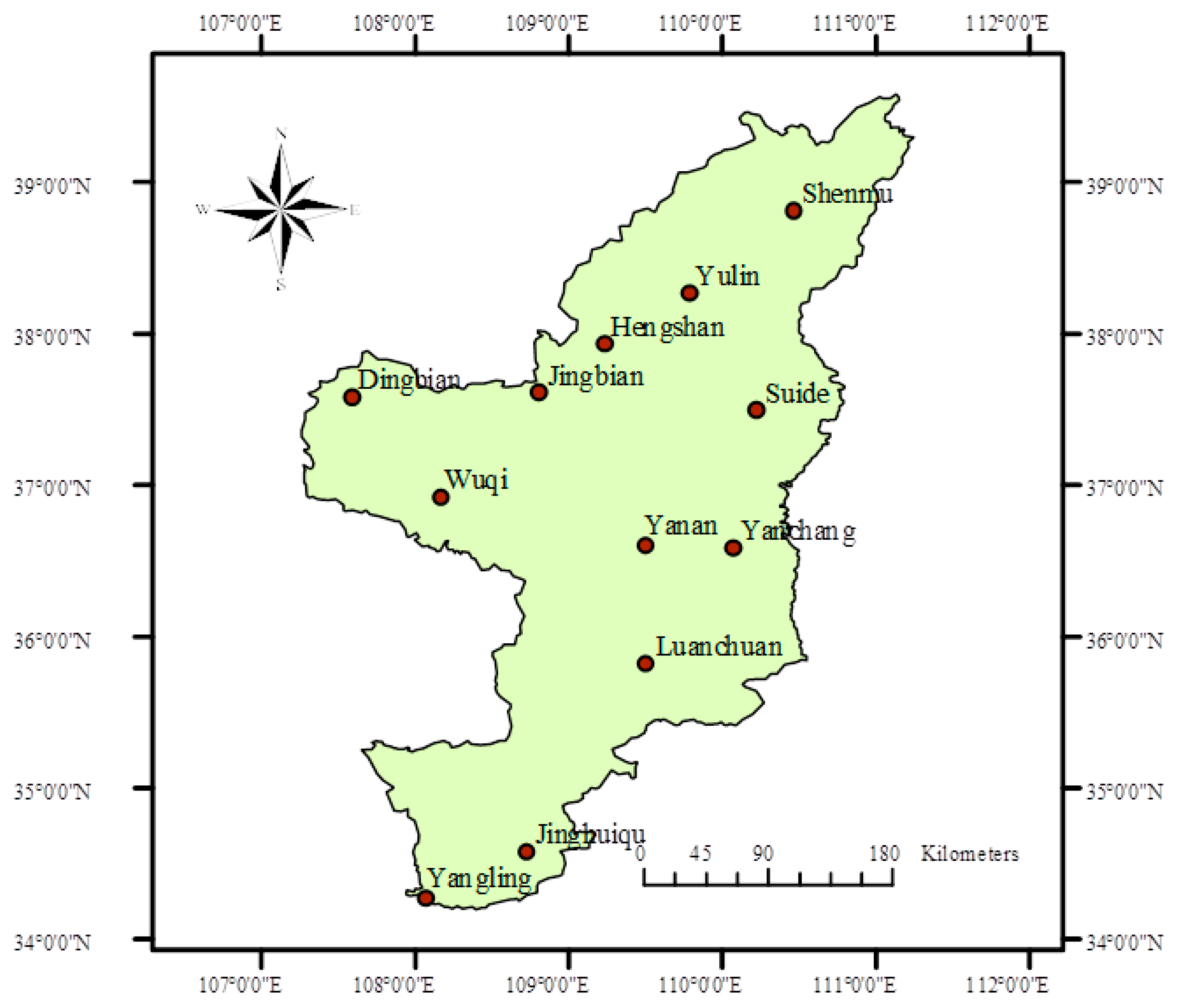


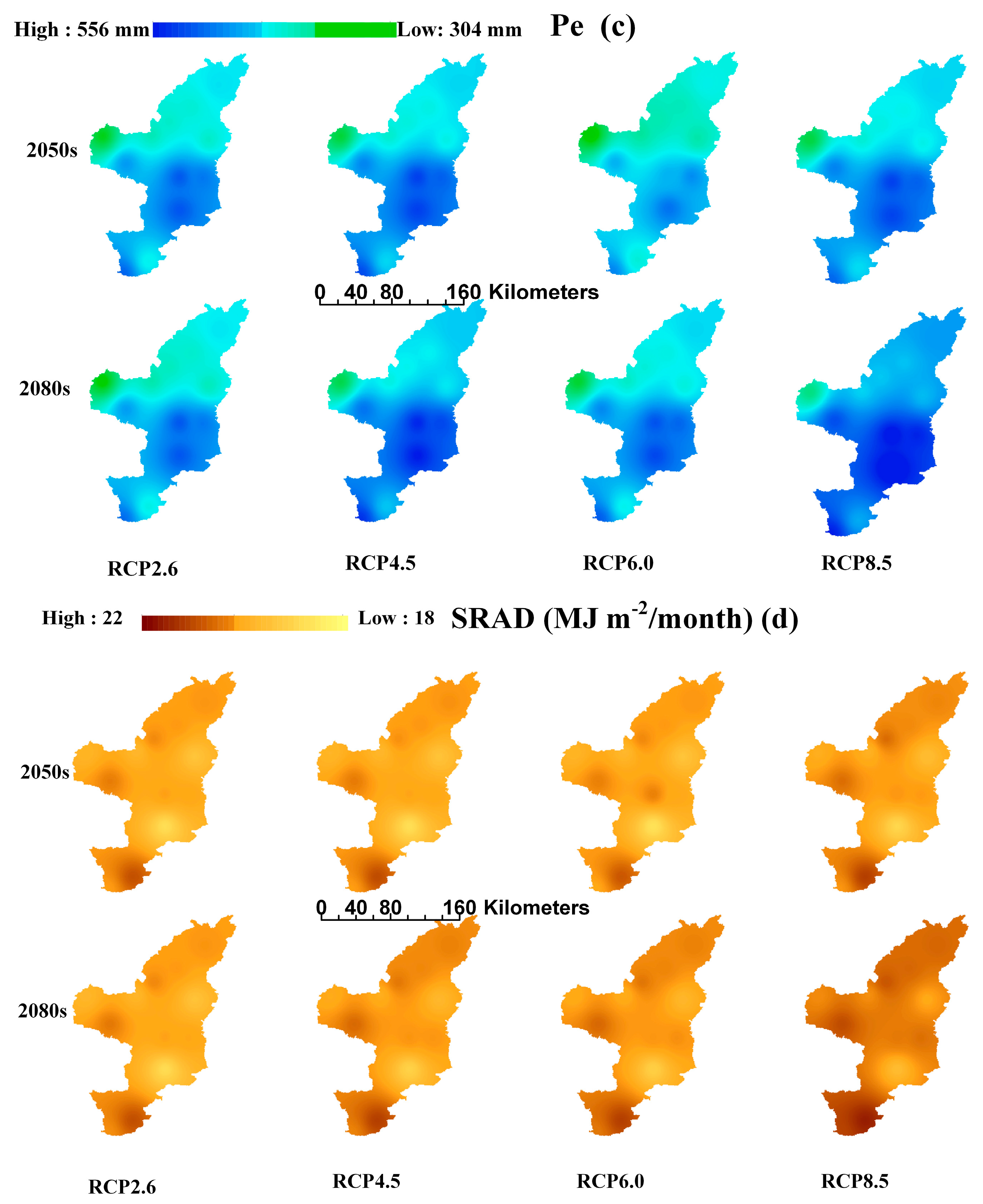


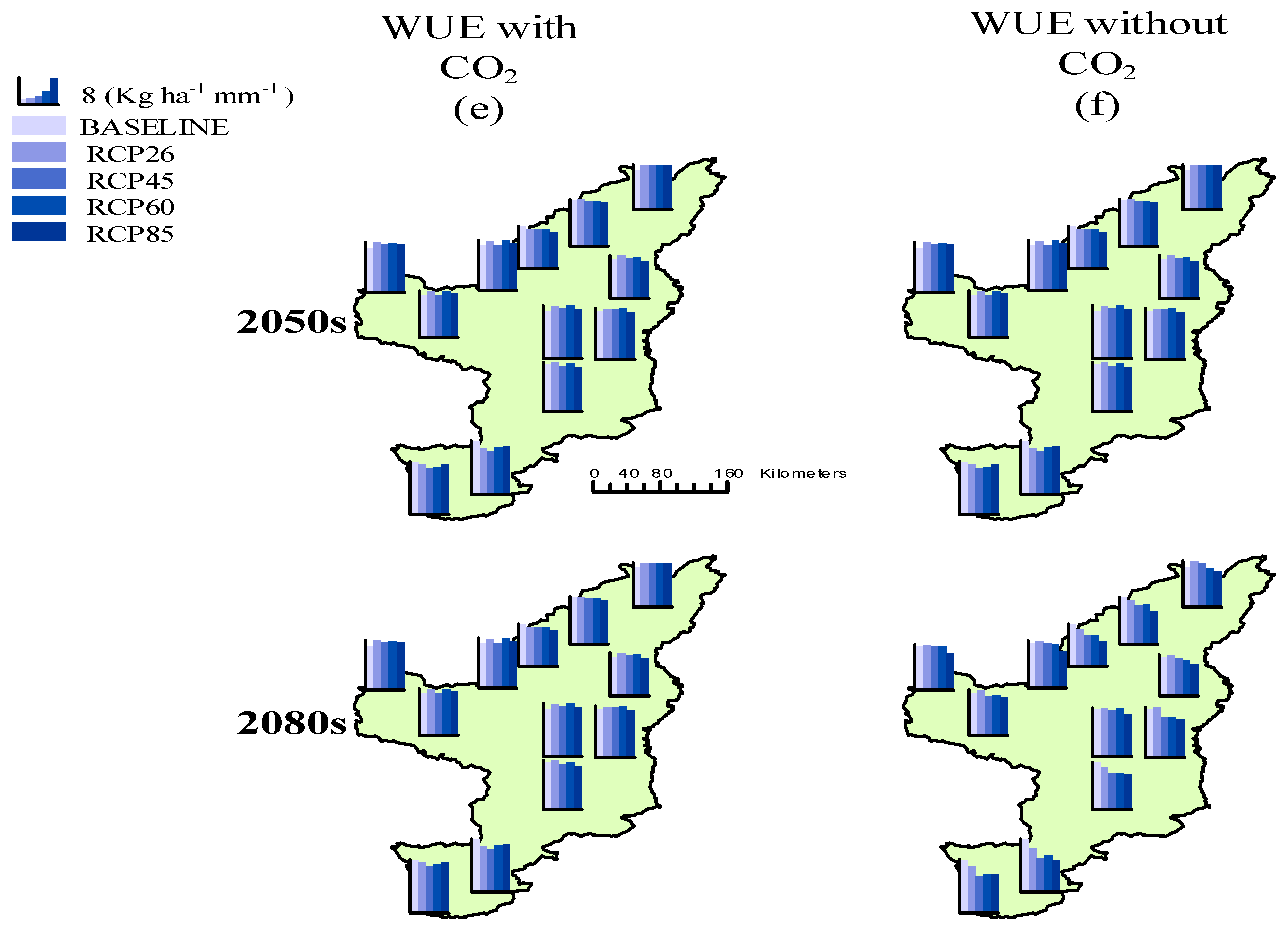
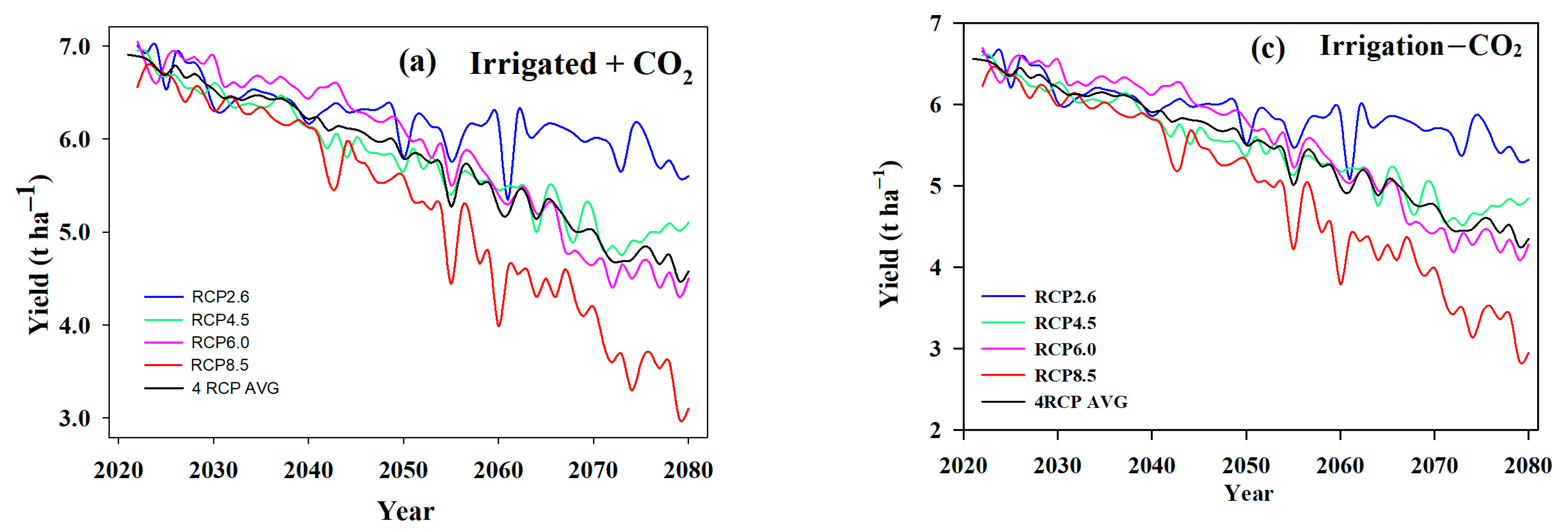
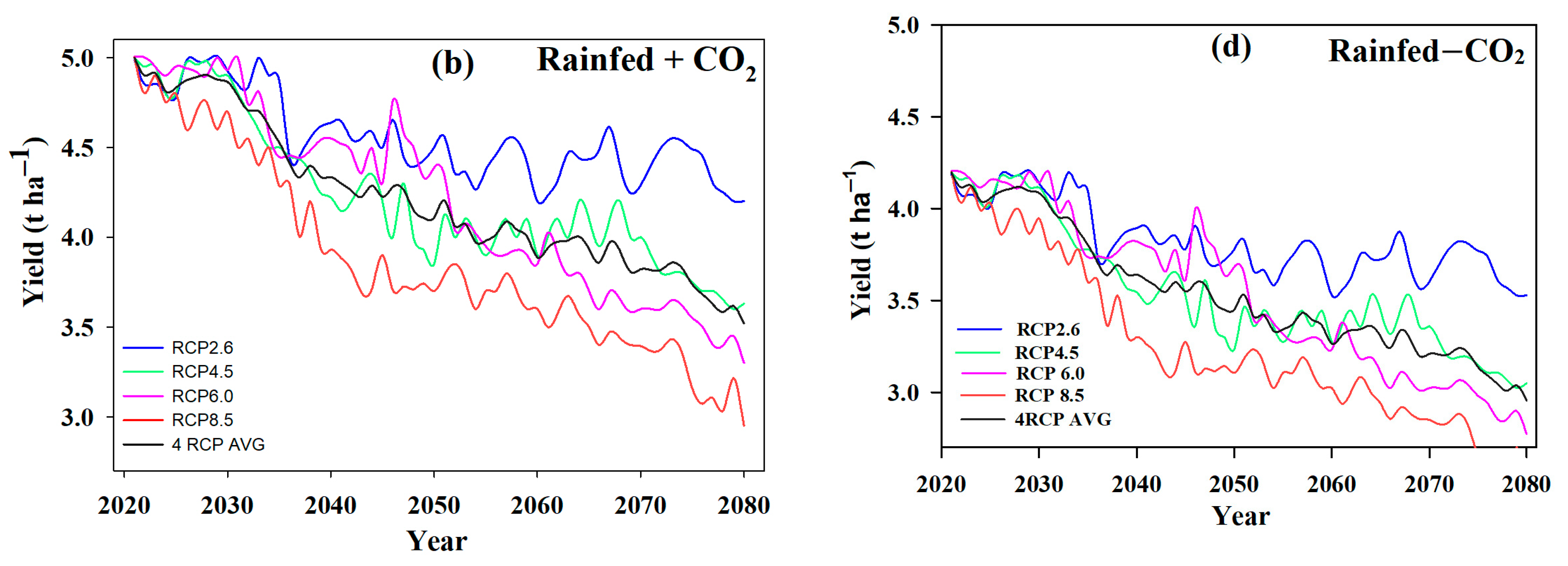
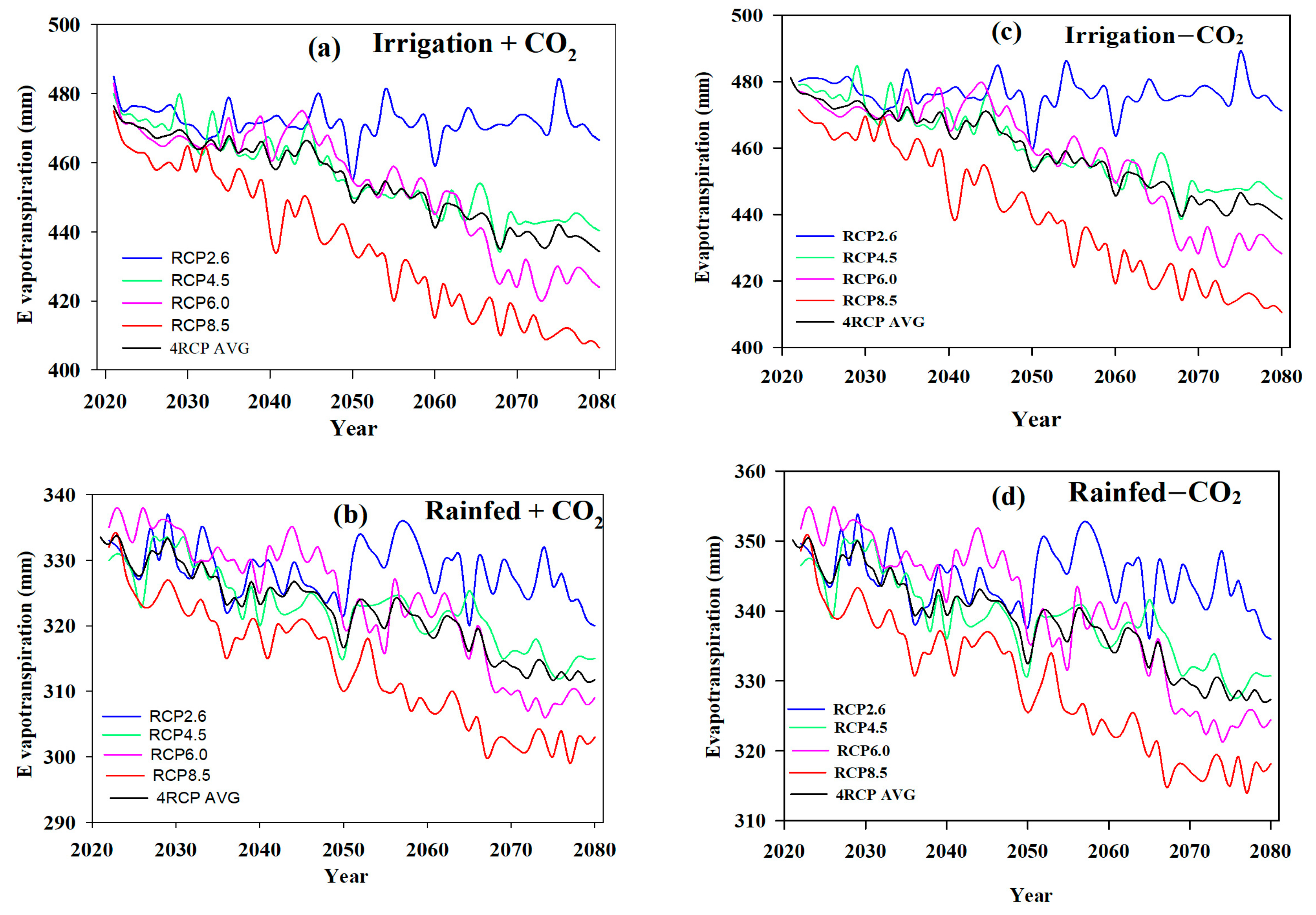
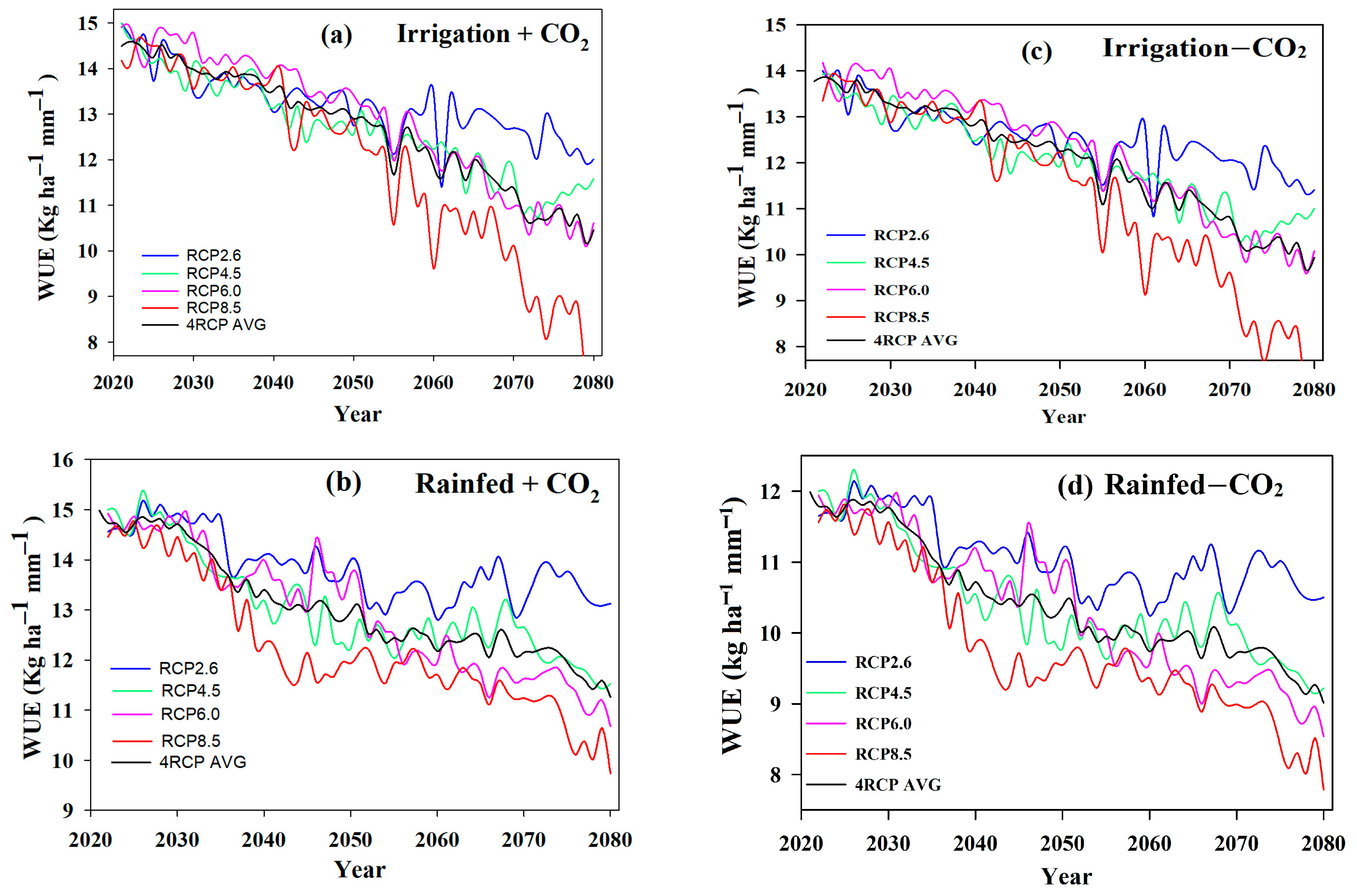
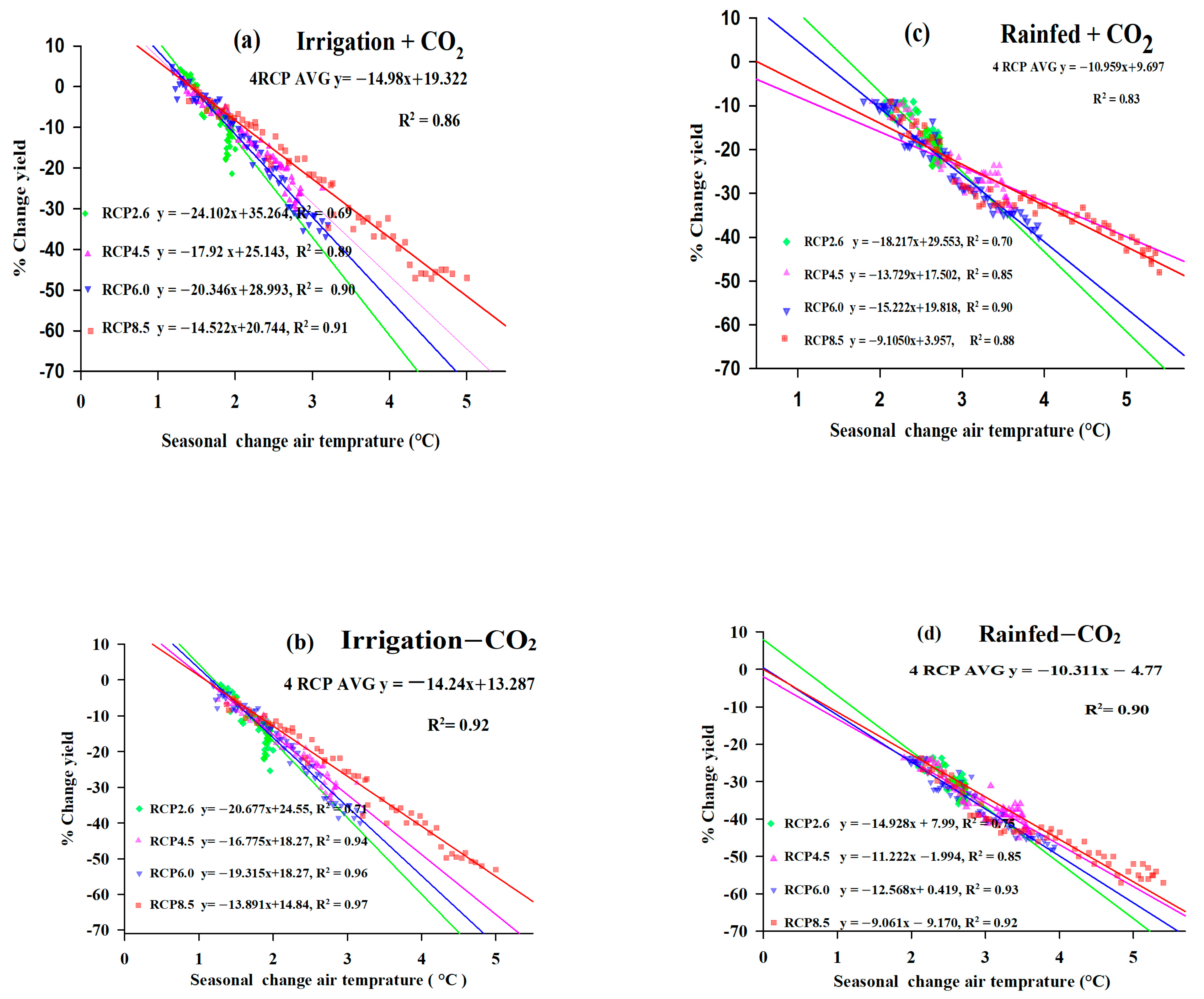
| Sr No. | Model | Institutions | Resolution, Lat.° × Long ° |
|---|---|---|---|
| 1 | BCC-CSM 1.1 | Beijing Climate Center, China Meteorological Administration, China | 2.8125 × 2.8125 |
| 2 | BCC-CSM 1.1(m) | Beijing Climate Center, China Meteorological Administration, China | 2.8125 × 2.8125 |
| 3 | CSIRO-Mk3.6.0 | CSIRO and the Queensland Climate Change Center of Excellence, Australia | 1.8750 × 1.8750 |
| 4 | FIO-ESM | The First Institute of Oceanography, China | 2.8120 × 2.8120 |
| 5 | GFDL-CM3 | Geophysical Fluid Dynamics Laboratory, USA | 2.0 × 2.5 |
| 6 | GFDL-ESM2G | Geophysical Fluid Dynamics Laboratory, USA | 2.0 × 2.5 |
| 7 | GFDL-ESM2M | Geophysical Fluid Dynamics Laboratory, USA | 2.0 × 2.5 |
| 8 | GISS-E2-H | NASA Goddard Institute for Space Studies, USA | 2.0 × 2.5 |
| 9 | GISS-E2-R | NASA Goddard Institute for Space Studies, USA | 2.0 × 2.5 |
| 10 | HadGEM2-ES | Met Office Hadley Centre, UK | 1.2414 × 1.8750 |
| 11 | IPSL-CM5A-LR | Institute Pierre-Simon Laplace, France | 1.8750 × 3.7500 |
| 12 | IPSL-CM5A-MR | Institute Pierre-Simon Laplace, France | 1.2587 × 2.5000 |
| 13 | MIROC-ESM | Atmosphere and Ocean Research Institute, National Institute for Environmental Studies and Japan Agency for Marine Earth Science and Technology, Japan | 2.8125 × 2.8125 |
| 14 | MIROC-ESM-CHEM | Atmosphere and Ocean Research Institute, National Institute for Environmental Studies and Japan Agency for Marine Earth Science and Technology, Japan | 2.8125 × 2.8125 |
| 15 | MIROC5 | Atmosphere and Ocean Research Institute, National Institute for Environmental Studies and Japan Agency for Marine Earth Science and Technology, Japan | 1.4063 × 1.4063 |
| 16 | MRI-CGCM3 | Meteorological Research Institute, Japan | 1.1250 × 1.1250 |
| 17 | NorESM1-M | Norwegian Climate Centre, Norway | 1.8750 × 2.5000 |
© 2020 by the authors. Licensee MDPI, Basel, Switzerland. This article is an open access article distributed under the terms and conditions of the Creative Commons Attribution (CC BY) license (http://creativecommons.org/licenses/by/4.0/).
Share and Cite
Saddique, Q.; Khan, M.I.; Habib ur Rahman, M.; Jiatun, X.; Waseem, M.; Gaiser, T.; Mohsin Waqas, M.; Ahmad, I.; Chong, L.; Cai, H. Effects of Elevated Air Temperature and CO2 on Maize Production and Water Use Efficiency under Future Climate Change Scenarios in Shaanxi Province, China. Atmosphere 2020, 11, 843. https://doi.org/10.3390/atmos11080843
Saddique Q, Khan MI, Habib ur Rahman M, Jiatun X, Waseem M, Gaiser T, Mohsin Waqas M, Ahmad I, Chong L, Cai H. Effects of Elevated Air Temperature and CO2 on Maize Production and Water Use Efficiency under Future Climate Change Scenarios in Shaanxi Province, China. Atmosphere. 2020; 11(8):843. https://doi.org/10.3390/atmos11080843
Chicago/Turabian StyleSaddique, Qaisar, Muhammad Imran Khan, Muhammad Habib ur Rahman, Xu Jiatun, Muhammad Waseem, Thomas Gaiser, Muhammad Mohsin Waqas, Ijaz Ahmad, Li Chong, and Huanjie Cai. 2020. "Effects of Elevated Air Temperature and CO2 on Maize Production and Water Use Efficiency under Future Climate Change Scenarios in Shaanxi Province, China" Atmosphere 11, no. 8: 843. https://doi.org/10.3390/atmos11080843
APA StyleSaddique, Q., Khan, M. I., Habib ur Rahman, M., Jiatun, X., Waseem, M., Gaiser, T., Mohsin Waqas, M., Ahmad, I., Chong, L., & Cai, H. (2020). Effects of Elevated Air Temperature and CO2 on Maize Production and Water Use Efficiency under Future Climate Change Scenarios in Shaanxi Province, China. Atmosphere, 11(8), 843. https://doi.org/10.3390/atmos11080843








